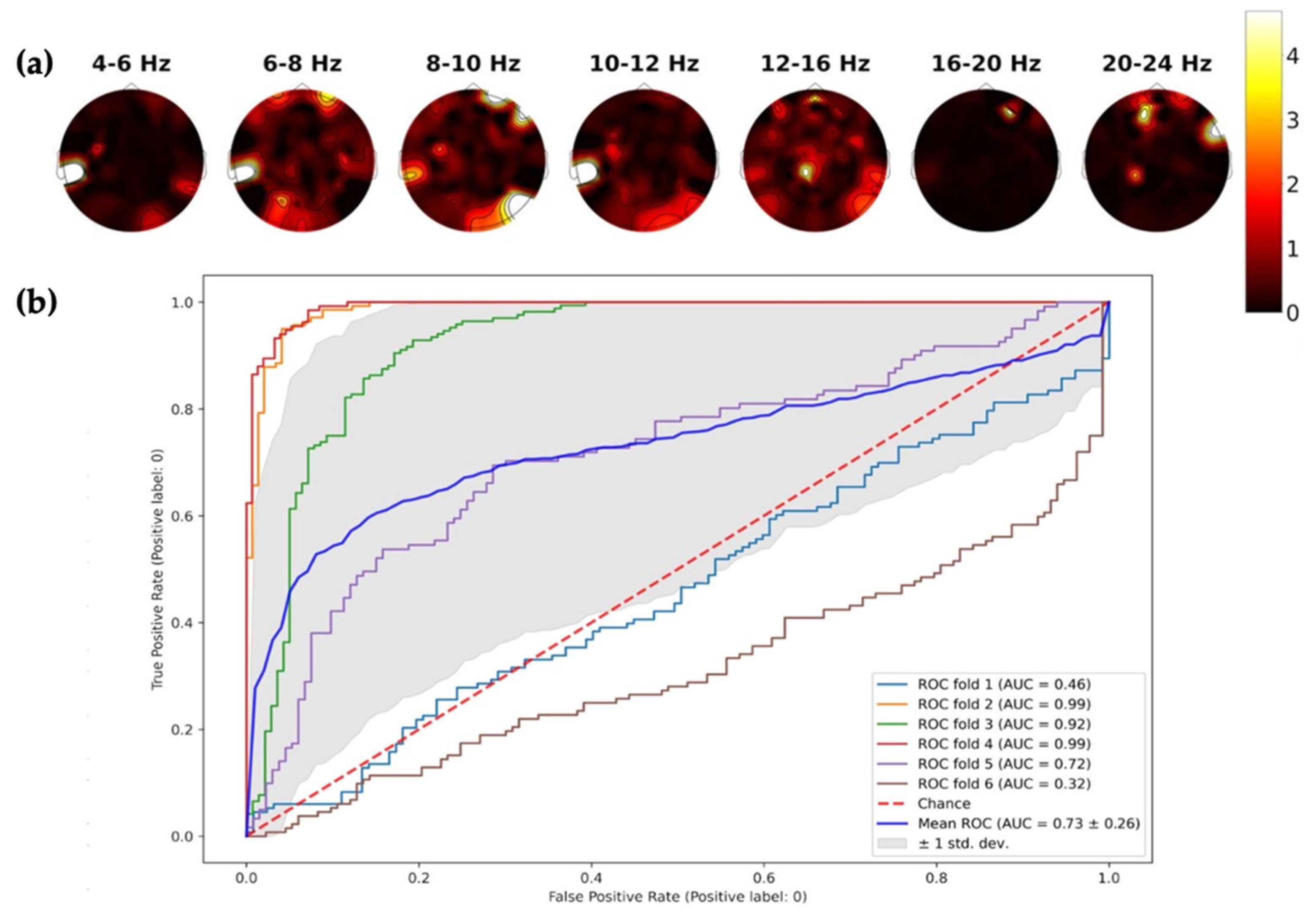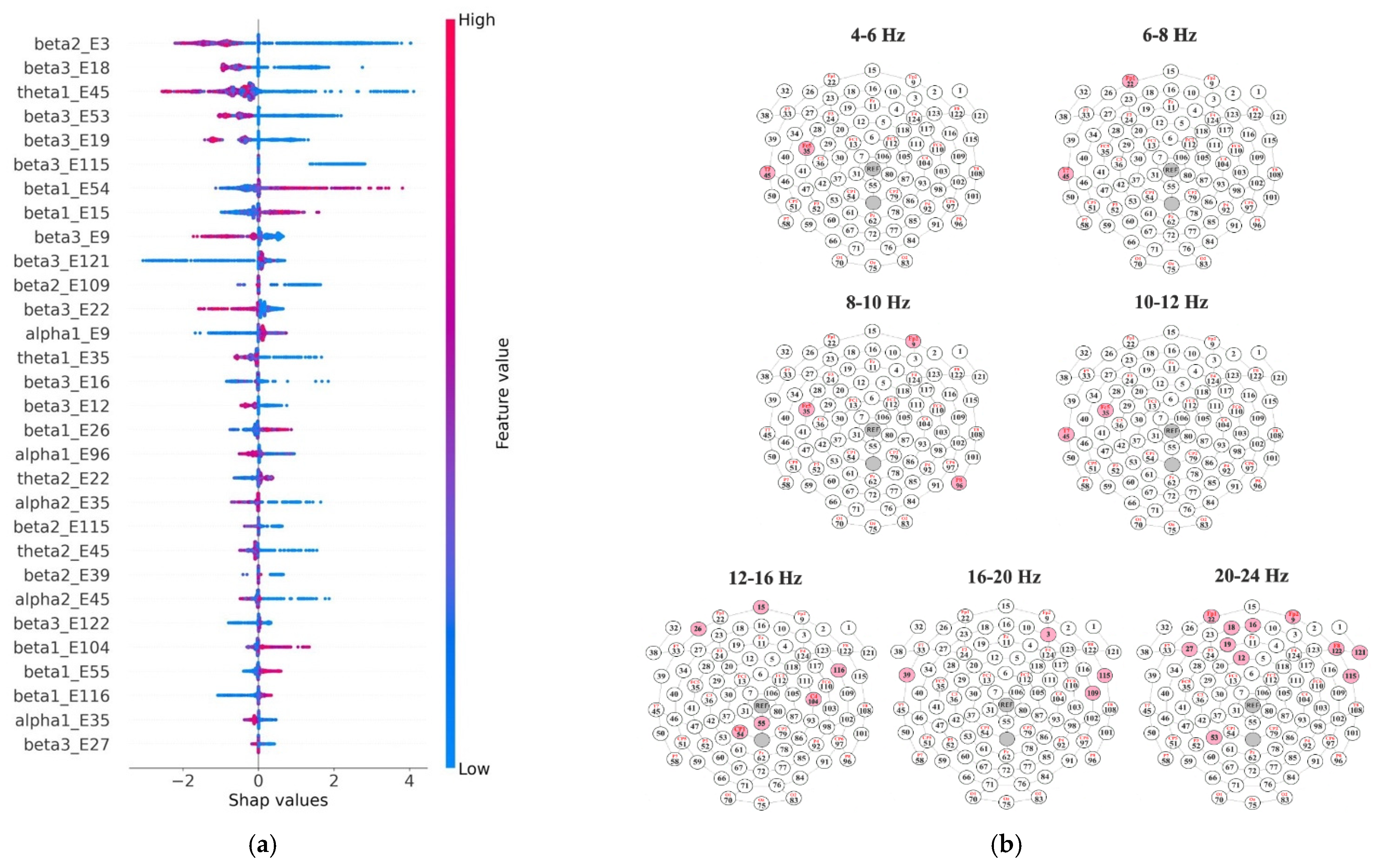Cross-Subject Classification of Effectiveness in Performing Cognitive Tasks Using Resting-State EEG
Abstract
:Featured Application
Abstract
1. Introduction
2. Materials and Methods
2.1. Participants
2.2. Experimental Design
2.3. EEG Recording and Preprocessing
2.4. Statistical Analysis of the Behavioral Data
2.5. Cluster-Based Permutation Test
2.6. Machine Learning Algorithm for Classification of EEG Patterns
3. Results
3.1. Behavioral Performance
3.2. Group Differences and Cross-Subject Group Classification
4. Discussion
5. Conclusions
Author Contributions
Funding
Institutional Review Board Statement
Informed Consent Statement
Data Availability Statement
Acknowledgments
Conflicts of Interest
References
- Webbink, D.; Hartog, J. Can students predict starting salaries? Yes! Econ. Educ. Rev. 2004, 23, 103–113. [Google Scholar] [CrossRef]
- Cox, D.D.; Percival, D.B.; Walden, A.T. Spectral Analysis for Physical Applications: Multitaper and Conventional Univariate Techniques. J. Am. Stat. Assoc. 1997, 92, 1226. [Google Scholar] [CrossRef]
- Ritchie, S.J.; Bates, T.C. Enduring Links From Childhood Mathematics and Reading Achievement to Adult Socioeconomic Status. Psychol. Sci. 2013, 24, 1301–1308. [Google Scholar] [CrossRef]
- Anzalone, C.; Luedke, J.C.; Green, J.J.; Decker, S.L. QEEG coherence patterns related to mathematics ability in children. Appl. Neuropsychol. Child. Oct. 2020, 11, 328–338. [Google Scholar] [CrossRef] [PubMed]
- Wang, L.; Cao, C.; Zhou, X.; Qi, C. Spatial abilities associated with open math problem solving. Appl. Cogn. Psychol. 2022, 36, 306–317. [Google Scholar] [CrossRef]
- Roik, A.O.; Ivanitskii, G.A. A Neurophysiological Model of the Cognitive Space. Neurosci. Behav. Physiol. 2013, 43, 193–199. [Google Scholar] [CrossRef]
- Núñez-Peña, M.I.; González-Gómez, B.; Colomé. Spatial processing in a mental rotation task: Differences between high and low math-anxiety individuals. Biol. Psychol. 2019, 146, 107727. [Google Scholar] [CrossRef]
- Arsalidou, M.; Pawliw-Levac, M.; Sadeghi, M.; Pascual-Leone, J. Brain areas associated with numbers and calculations in children: Meta-analyses of fMRI studies. Dev. Cogn. Neurosci. 2018, 30, 239–250. [Google Scholar] [CrossRef]
- Alnajashi, S. Alpha and theta oscillations in mental addition for high and low performers. Cogn. Process. 2021, 22, 609–626. [Google Scholar] [CrossRef] [PubMed]
- Amalric, M.; Dehaene, S. Origins of the brain networks for advanced mathematics in expert mathematicians. Proc. Natl. Acad. Sci. USA 2016, 113, 4909–4917. [Google Scholar] [CrossRef]
- Steiner, H.; Martynova, O. Task-related and Resting-state EEG Correlates of Mathematical Skills. In Proceedings of the Fourth International Conference Neurotechnologies Neurointerfaces (CNN)/Neurotechnologies Neurointerfaces (CNN), Kaliningrad, Russia, 14–16 September 2022. [Google Scholar] [CrossRef]
- Chemerisova, E.V.; Atanov, M.S.; Mikheev, I.N.; Martynova, O.V. Classification of verbal and mathematical mental operations based on power spectral density of EEG. Pscyhology. J. High. Sch. Econ. 2018, 15, 268–278. [Google Scholar] [CrossRef]
- Hinault, T.; Lemaire, P. What does EEG tell us about arithmetic strategies? A review. Int. J. Psychophysiol. 2016, 106, 115–126. [Google Scholar] [CrossRef] [PubMed]
- Amin, H.U.; Mumtaz, W.; Subhani, A.R.; Saad, M.N.M.; Malik, A.S. Classification of EEG Signals Based on Pattern Recognition Approach. Front. Comput. Neurosci. 2017, 11, 103. [Google Scholar] [CrossRef] [PubMed]
- Anokhin, A.P. Genetic psychophysiology: Advances, problems, and future directions. Int. J. Psychophysiol. 2014, 93, 173–197. [Google Scholar] [CrossRef]
- Iacono, W.G.; Malone, S.M.; Vrieze, S.I. Endophenotype best practices. Int. J. Psychophysiol. 2017, 111, 115–144. [Google Scholar] [CrossRef] [PubMed]
- Ponomareva, N.V.; Andreeva, T.V.; Protasova, M.; Konovalov, R.N.; Krotenkova, M.V.; Kolesnikova, E.P.; Malina, D.D.; Kanavets, E.V.; Mitrofanov, A.A.; Fokin, V.F.; et al. Genetic association of apolipoprotein E genotype with EEG alpha rhythm slowing and functional brain network alterations during normal aging. Front. Neurosci. 2022, 16, 931173. [Google Scholar] [CrossRef]
- Mennes, M.; Kelly, C.; Zuo, X.-N.; Di Martino, A.; Biswal, B.B.; Castellanos, F.X.; Milham, M.P. Inter-individual differences in resting-state functional connectivity predict task-induced BOLD activity. Neuroimage 2010, 50, 1690–1701. [Google Scholar] [CrossRef]
- Cole, M.W.; Yarkoni, T.; Repovs, G.; Anticevic, A.; Braver, T.S. Global Connectivity of Prefrontal Cortex Predicts Cognitive Control and Intelligence. J. Neurosci. 2012, 32, 8988–8999. [Google Scholar] [CrossRef]
- Rogala, J.; Kublik, E.; Krauz, R.; Wróbel, A. Resting-state EEG activity predicts frontoparietal network reconfiguration and improved attentional performance. Sci. Rep. 2020, 10, 5064. [Google Scholar] [CrossRef]
- Kounios, J.; Fleck, J.I.; Green, D.L.; Payne, L.; Stevenson, J.L.; Bowden, E.M.; Jung-Beeman, M. The origins of insight in resting-state brain activity. Neuropsychologia 2008, 46, 281–291. [Google Scholar] [CrossRef]
- Zeng, H.; Li, X.; Borghini, G.; Zhao, Y.; Aricò, P.; Di Flumeri, G.; Sciaraffa, N.; Zakaria, W.; Kong, W.; Babiloni, F. An EEG-Based Transfer Learning Method for Cross-Subject Fatigue Mental State Prediction. Sensors 2021, 21, 2369. [Google Scholar] [CrossRef] [PubMed]
- Ray, A.M.; Sitaram, R.; Rana, M.; Pasqualotto, E.; Buyukturkoglu, K.; Guan, C.; Ang, K.-K.; Tejos, C.; Zamorano, F.; Aboitiz, F.; et al. A subject-independent pattern-based Brain-Computer Interface. Front. Behav. Neurosci. 2015, 9, 269. [Google Scholar] [CrossRef] [PubMed]
- Babiloni, F.; Cincotti, F.; Lazzarini, L.; Millan, J.; Mourino, J.; Varsta, M.; Heikkonen, J.; Bianchi, L.; Marciani, M.G. Linear classification of low-resolution EEG patterns produced by imagined hand movements. IEEE Trans. Rehabil. Eng. 2000, 8, 186–188. [Google Scholar] [CrossRef] [PubMed]
- Gysels, E.; del Chiappa, S.R.M.J.; Celka, P. Studying Phase Synchrony for Classification of Mental Tasks in Brain Machine Interfaces. In Proceedings of the Conference of the International Society for Brain Electromagnetic Topography, Santa Fe, CA, USA, 19–23 November 2003. [Google Scholar]
- Maris, E.; Oostenveld, R. Nonparametric statistical testing of EEG- and MEG-data. J. Neurosci. Methods 2007, 164, 177–190. [Google Scholar] [CrossRef] [PubMed]
- Wan, W.; Cui, X.; Gao, Z.; Gu, Z. Frontal EEG-Based Multi-Level Attention States Recognition Using Dynamical Complexity and Extreme Gradient Boosting. Front. Hum. Neurosci. 2021, 15, 673955. [Google Scholar] [CrossRef]
- Lundberg, S.; Su-In, L. A Unified Approach to Interpreting Model Predictions. In Proceedings of the Conference on Neural Information Processing Systems, Long Beach, CA, USA, 4–9 December 2017. [Google Scholar] [CrossRef]
- Krauledat, M.; Dornhege, G.; Blankertz, B.; Müller, K.-R. Robustifying EEG data analysis by removing outliers. Chaos Comple. Lett. 2007, 2, 259–274. [Google Scholar]
- Saha, S.; Ahmed, K.I.; Mostafa, R.; Khandoker, A.H.; Hadjileontiadis, L. Enhanced inter-subject brain computer interface with associative sensorimotor oscillations. Health. Technol. Lett. 2017, 4, 39–43. [Google Scholar] [CrossRef]
- Ishii, R.; Canuet, L.; Ishihara, T.; Aoki, Y.; Ikeda, S.; Hata, M.; Katsimichas, T.; Gunji, A.; Takahashi, H.; Nakahachi, T.; et al. Frontal midline theta rhythm and gamma power changes during focused attention on mental calculation: An MEG beamformer analysis. Front. Hum. Neurosci. 2014, 8, 406. [Google Scholar] [CrossRef]
- Cavanagh, J.F.; Frank, M.J. Frontal theta as a mechanism for cognitive control. Trends Cogn. Sci. 2014, 18, 414–421. [Google Scholar] [CrossRef]
- Harper, J.; Liu, M.; Malone, S.M.; McGue, M.; Iacono, W.G.; Vrieze, S.I. Using multivariate endophenotypes to identify psychophysiological mechanisms associated with polygenic scores for substance use, schizophrenia, and education attainment. Psychol. Med. 2022, 52, 3913–3923. [Google Scholar] [CrossRef]
- Sherfey, J.; Ardid, S.; Miller, E.K.; Hasselmo, M.E.; Kopell, N.J. Prefrontal oscillations modulate the propagation of neuronal activity required for working memory. Neurobiol Learn. Mem. 2020, 173, 107228. [Google Scholar] [CrossRef] [PubMed]
- Bastos, A.M.; Loonis, R.; Kornblith, S.; Lundqvist, M.; Miller, E.K. Laminar recordings in frontal cortex suggest distinct layers for maintenance and control of working memory. Proc. Natl. Acad. Sci. USA 2018, 115, 1117–1122. [Google Scholar] [CrossRef] [PubMed]




| Group/Social-Demographic Status | Total, n | Male, n | Age, Mean ± StDev | AM, n | BM, n |
|---|---|---|---|---|---|
| AM | 12 | 9 | 27.00 ± 5.36 | - | - |
| BM | 14 | 5 | 24.64 ± 4.47 | - | - |
| HS: DT < median | 13 | 9 | 25.15 ± 5.16 | 7 | 6 |
| MS: DT > median | 13 | 5 | 26.31 ± 4.85 | 5 | 8 |
| SAM: DT < median in AM group | 6 | 5 | 23.83 ± 4.17 | - | - |
| SBM: DT < median in BM group | 6 | 3 | 24.33 ± 3.27 | - | - |
| LAM: DT > median in AM group | 6 | 4 | 30.17 ± 4.67 | - | - |
| LBM: DT > median in BM group | 6 | 2 | 22.50 ± 1.97 | - | - |
| Task Group | Task Specification | Example | Number of Tasks |
|---|---|---|---|
| Verbal | Five-letters anagrams | O E S G O (goose) | 30 |
| Six-letters anagrams | R L O F E D (folder) | 30 | |
| Arithmetic | Addition | 44 + 66 + 12 + 7 | 12 |
| Subtraction | 6435−4846 | 12 | |
| Multiplication | 27 × 9 + 5 × 6 | 24 | |
| Fraction | 7/12–4/10 | 12 | |
| Logical | Arithmetic sequences | 93; 82; 41; 30; 15 | 60 |
| Group | Verbal | Arithmetic | Logical | |||
|---|---|---|---|---|---|---|
| CA | DT | CA | DT | CA | DT | |
| AM | 78.19 ± 11.16 | 11.59 ± 3.80 | 78.61 ± 10.51 | 18.83 ± 3.79 | 77.22 ± 17.40 | 15.75 ± 4.45 |
| BM | 76.19 ± 13.28 | 12.14 ± 4.50 | 65.71 ± 17.57 | 22.71 ± 4.16 | 69.64 ± 21.01 | 18.21 ± 3.53 |
| HS | 49.77 ± 5.33 | 9.58 ± 3.40 | 49.15 ± 4.58 | 17.04 ± 2.85 | 49.00 ± 9.30 | 12.80 ± 2.06 |
| MS | 42.77 ± 7.46 | 13.67 ± 3.30 | 36.85 ± 9.28 | 22.35 ± 2.38 | 38.77 ± 11,83 | 18.23 ± 2.28 |
| SAM | 50.33 ± 5.39 | 9.66 ±4.09 | 50.33 ± 5.65 | 15.49 ± 2.43 | 49.00 ± 12.95 | 11.42 ± 1.61 |
| SBM | 50.50 ± 5.09 | 8.92 ± 2.85 | 48.17 ± 3.92 | 18.44 ± 2.86 | 49.83 ± 5.85 | 14.15 ± 1.74 |
| LAM | 43.50 ± 6.44 | 13.11 ± 2.69 | 44.00 ± 5.62 | 20.43 ± 2.32 | 43.67 ± 7.42 | 17.01 ± 3.76 |
| LBM | 38.67 ± 5.79 | 15.34 ± 2.87 | 32.50 ± 10.44 | 23.50 ± 2.43 | 32.50 ± 13.69 | 18.81 ± 1.17 |
Disclaimer/Publisher’s Note: The statements, opinions and data contained in all publications are solely those of the individual author(s) and contributor(s) and not of MDPI and/or the editor(s). MDPI and/or the editor(s) disclaim responsibility for any injury to people or property resulting from any ideas, methods, instructions or products referred to in the content. |
© 2023 by the authors. Licensee MDPI, Basel, Switzerland. This article is an open access article distributed under the terms and conditions of the Creative Commons Attribution (CC BY) license (https://creativecommons.org/licenses/by/4.0/).
Share and Cite
Steiner, H.; Mikheev, I.; Martynova, O. Cross-Subject Classification of Effectiveness in Performing Cognitive Tasks Using Resting-State EEG. Appl. Sci. 2023, 13, 6606. https://doi.org/10.3390/app13116606
Steiner H, Mikheev I, Martynova O. Cross-Subject Classification of Effectiveness in Performing Cognitive Tasks Using Resting-State EEG. Applied Sciences. 2023; 13(11):6606. https://doi.org/10.3390/app13116606
Chicago/Turabian StyleSteiner, Helen, Ilya Mikheev, and Olga Martynova. 2023. "Cross-Subject Classification of Effectiveness in Performing Cognitive Tasks Using Resting-State EEG" Applied Sciences 13, no. 11: 6606. https://doi.org/10.3390/app13116606
APA StyleSteiner, H., Mikheev, I., & Martynova, O. (2023). Cross-Subject Classification of Effectiveness in Performing Cognitive Tasks Using Resting-State EEG. Applied Sciences, 13(11), 6606. https://doi.org/10.3390/app13116606






